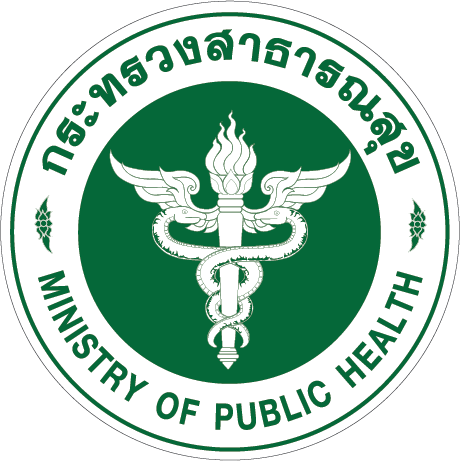ผลการใช้ค่าประมาณอัตราการกรองผ่านโกลเมอรูลัสเป็นตัวส่งสัญญาณในการเฝ้าระวังการเกิดพิษต่อไตจากยาแวนโคมัยซิน
คำสำคัญ:
แวนโคมัยซิน, ความเป็นพิษต่อไต, ไตวายเฉียบพลัน, ตัวส่งสัญญาณเฝ้าระวังอาการไม่พึงประสงค์บทคัดย่อ
ความเป็นมา: แวนโคมัยซิน (vancomycin) เป็นยาต้านจุลชีพที่ออกฤทธิ์กว้าง มีฤทธิ์ฆ่าเชื้อแบคทีเรียแกรมบวกรวมทั้ง methicillin resistance Staphylococcus aureus (MRSA) อาการไม่พึงประสงค์สำคัญของยา คือ การเกิดพิษต่อไต (vancomycin induced nephrotoxicity) ซึ่งเป็นอาการไม่พึงประสงค์ที่สามารถป้องกันได้ หากมีการตรวจพบและแก้ไขอย่างรวดเร็วก็จะสามารถทำให้การทำงานของไตกลับมาเป็นปกติได้
วัตถุประสงค์: งานวิจัยนี้มีวัตถุประสงค์เพื่อประเมินผลของการใช้ค่าประมาณอัตราการกรองผ่านโกลเมอรูลัสเป็นตัวส่งสัญญาณในการเกิดพิษต่อไตจาก vancomycin (eGFR trigger tool) ตลอดจนศึกษาปัจจัยที่มีความสัมพันธ์ต่อการเพิ่มความเสี่ยงในการเกิดพิษต่อไต ในผู้ป่วยที่ได้รับ vancomycin
วิธีการวิจัย: เป็นการศึกษาย้อนหลังโดยเปรียบเทียบข้อมูลก่อนและหลังทดลองใช้ระบบ eGFR trigger tool ในผู้ป่วยที่ได้รับ vancomycin ฉีดเข้าทางหลอดเลือดดำ มาแล้วไม่ต่ำกว่า 48 ชั่วโมง ในสถาบันโรคทรวงอก โดยมีระยะเวลาช่วงละ 1 ปี คือ ระหว่างวันที่ 1 ตุลาคม พ.ศ.2560 ถึง 30 กันยายน พ.ศ.2562 ผู้ป่วยจะได้รับการติดตามจนกว่าจะหยุดใช้ยา และประเมินการเกิดพิษต่อไต โดยใช้เกณฑ์คือค่าอัตราการกรองผ่านโกลเมอรูลัสเพิ่มขึ้นมากกว่าหรือเท่ากับร้อยละ 25 ภายใน 48 ชั่วโมง หรือค่าซีรัมครีเอตินีนเพิ่มขึ้นมากกว่าหรือเท่ากับ 1.5 เท่าของค่าพื้นฐาน
ผลการวิจัย: ผู้ป่วยที่ได้รับคัดเลือกเข้าการศึกษาจำนวนทั้งหมด 366 คน แบ่งเป็นก่อนใช้ eGFR trigger tool จำนวน 157 คน และ หลังใช้ eGFR trigger tool จำนวน 179 คน พบว่าก่อนใช้ eGFR trigger tool ผู้ป่วยเกิดไตวายเฉียบพลัน 54 ราย (ร้อยละ 34.4) และหลังใช้ eGFR trigger tool จำนวน 34 ราย (ร้อยละ 19) ลดลงอย่างมีนัยสำคัญเมื่อเทียบกับก่อนใช้ eGFR trigger tool (p = 0.002) และอุบัติการณ์เกิดพิษต่อไตจาก vancomycin จะเพิ่มขึ้นอย่างมีนัยสำคัญทางสถิติในผู้ป่วยสูงอายุ (>70 ปี) ผู้ป่วยที่ได้รับยานานกว่า 14 วัน และผู้ป่วยที่ได้รับ gentamycin หรือ colistin ร่วมด้วย (p = 0.012, p = 0.043, p = 0.044 และ p = 0.048 ตามลำดับ)
สรุปผล: หลังเริ่มใช้ค่า eGFR trigger tool พบว่าผู้ป่วยที่ได้รับ vancomycin มีอุบัติการณ์เกิดไตวายเฉียบพลันต่ำกว่าก่อนใช้ eGFR trigger tool อย่างมีนัยสำคัญ และปัจจัยที่มีความสัมพันธ์กับการเกิดพิษต่อไต ได้แก่ ผู้ป่วยที่มีอายุมากกว่า 70 ปี ผู้ป่วยที่ได้รับยานานกว่า 14 วัน และการได้รับยาที่มีพิษต่อไตชนิดอื่น ๆ ร่วมด้วย
เอกสารอ้างอิง
Kasmar AG, Hooper D. Pharmacology of bacterial infection: cell wall synthesis. In: Golan DE, Tashjian AH Jr, Armstrong EJ, Armstrong AW, editors. Principles of pharmacology: The pathophysiologic basis of drug therapy. 2nd ed. Baltimore: Lippincott Williams & Wilkins; 2008. p. 601-18.
Mc Evoy GK. AHFS Drug Information 2005. Bethesda, American Society of Health-System Pharmacists; 2005. p. 467-71.
Liu C, Bayer A, Cosgrove S, Daum R, Fridkin S, Gorwitz R, et al. Clinical practice guidelines by the Infectious Diseases Society of America for the treatment of methicillin-resistant Staphylococcus aureus infections in adults and children. Clinical infectious diseases: an official publication of the Infectious Diseases Society of America. [Internet]. 2011 [cited 2021 Dec 11];52(3):e18-e55. Available from: https://www.researchgate.net/publication/49731385
Kett DH, Cano E, Quartin AA, Mangino JE, Zervos MJ, Peyrani P, et al. Implementation of guidelines for management of possible multidrug-resistant pneumonia in intensive care: An observational, multicentre cohort study. Lancet Infect Dis. 2011;11(3):181-9.
Elyasi S, Khalili H, Dashti-Khavidaki S, Mohammadpour A. vancomycin-induced nephrotoxicity: Mechanism, incidence, risk factors and special populations. A literature review. Eur J Clin Pharmacol. 2012;68(9):1243-55
Hanrahan TP, Kotapati C, Roberts MJ, Rowland J, Lipman J, Roberts JA, et al. Factors associated with vancomycin nephrotoxicity in the critically ill. Anaesth Intensive Care. 2015;43(5):594-9
Rybak MJ, Albrecht LM, Boike SC, Chandrasekar PH. Nephrotoxicity of vancomycin, alone and with an aminoglycoside. J Antimicrob Chemother. 1990;25(4):679-87.
Rybak M, Lomaestro B, Rotschafer JC, Moellering R, Jr., Craig W, Billeter M, et al. Therapeutic monitoring of vancomycin in adult patients: A consensus review of the American Society of Health-System Pharmacists, the Infectious Diseases Society of America, and the Society of Infectious Diseases Pharmacists. Am J Health Syst Pharm. 2009;66(1):82-98
Winter ME. Basic clinical pharmacokinetics. Philadelphia: Wolters Kluwer/Lippincott Williams & Wilkins Health; 2010
Bagshaw SM, George C, Bellomo R. A comparison of the RIFLE and AKIN criteria for acute kidney injury in critically ill patients. Nephrol Dial Transplant. 2008;23(5):1569-74.
Mehta RL, Kellum JA, Shah SV, Molitoris BA, Ronco C, Warnock DG, et al. Acute Kidney Injury Network: Report of an initiative to improve outcomes in acute kidney injury. Crit Care. 2007;11(2):R31
Kellum JA, Lameire N, Aspelin P, Barsoum RS, Burdmann EA, Goldstein SL, et al. Kidney disease: Improving global outcomes (KDIGO) acute kidney injury work group. KDIGO clinical practice guideline for acute kidney injury. 2012;2(1):1-138.

ดาวน์โหลด
เผยแพร่แล้ว
วิธีการอ้างอิง
ฉบับ
บท
การอนุญาต
ลิขสิทธิ์ (c) 2022 กองบริหารการสาธารณสุข สำนักงานปลัดกระทรวงสาธารณสุข และ ชมรมเภสัชกรโรงพยาบาลกระทรวงสาธารณสุข

This work is licensed under a Creative Commons Attribution-NonCommercial-NoDerivatives 4.0 International License.
ข้อความภายในบทความที่ตีพิมพ์ในวารสารเภสัชกรรมคลินิกทั้งหมด รวมถึงรูปภาพประกอบ ตาราง เป็นลิขสิทธิ์ของกองบริหารการสาธารณสุข สำนักงานปลัดกระทรวงสาธารณสุข และ ชมรมเภสัชกรโรงพยาบาลกระทรวงสาธารณสุข การนำเนื้อหา ข้อความหรือข้อคิดเห็น รูปภาพ ตาราง ของบทความไปจัดพิมพ์เผยแพร่ในรูปแบบต่าง ๆ เพื่อใช้ประโยชน์ในเชิงพาณิชย์ ต้องได้รับอนุญาตจากกองบรรณาธิการวารสารเภสัชกรรมคลินิกอย่างเป็นลายลักษณ์อักษร
กองบริหารการสาธารณสุข สำนักงานปลัดกระทรวงสาธารณสุข และ ชมรมเภสัชกรโรงพยาบาลกระทรวงสาธารณสุข อนุญาตให้สามารถนำไฟล์บทความไปใช้ประโยชน์และเผยแพร่ต่อได้ โดยอยู่ภายใต้เงื่อนไขสัญญาอนุญาตครีเอทีฟคอมมอน (Creative Commons License: CC) โดย ต้องแสดงที่มาจากวารสาร – ไม่ใช้เพื่อการค้า – ห้ามแก้ไขดัดแปลง, Attribution-NonCommercial-NoDerivatives 4.0 International (CC BY-NC-ND 4.0)
ข้อความที่ปรากฏในบทความในวารสารเป็นความคิดเห็นส่วนตัวของผู้เขียนแต่ละท่านไม่เกี่ยวข้องกับกองบริหารการสาธารณสุข สำนักงานปลัดกระทรวงสาธารณสุข และ ชมรมเภสัชกรโรงพยาบาลกระทรวงสาธารณสุข และบุคลากรในกองฯ หรือ ชมรมฯ แต่อย่างใด ความรับผิดชอบองค์ประกอบทั้งหมดของบทความแต่ละเรื่องเป็นของผู้เขียนแต่ละท่าน หากมีความผิดพลาดใด ๆ ผู้เขียนแต่ละท่านจะรับผิดชอบบทความของตนเอง ตลอดจนความรับผิดชอบด้านเนื้อหาและการตรวจร่างบทความเป็นของผู้เขียน ไม่เกี่ยวข้องกับกองบรรณาธิการ



